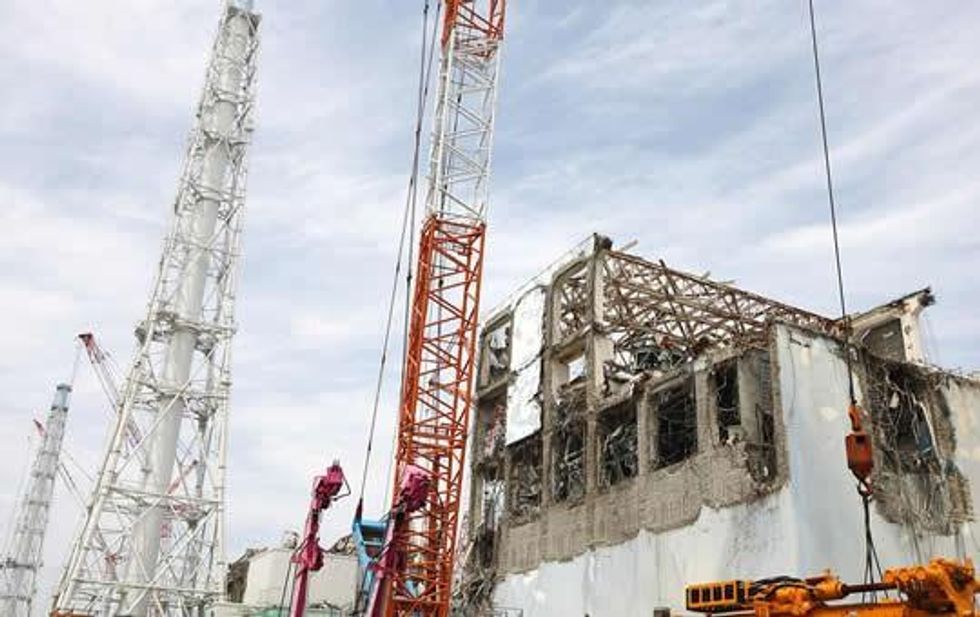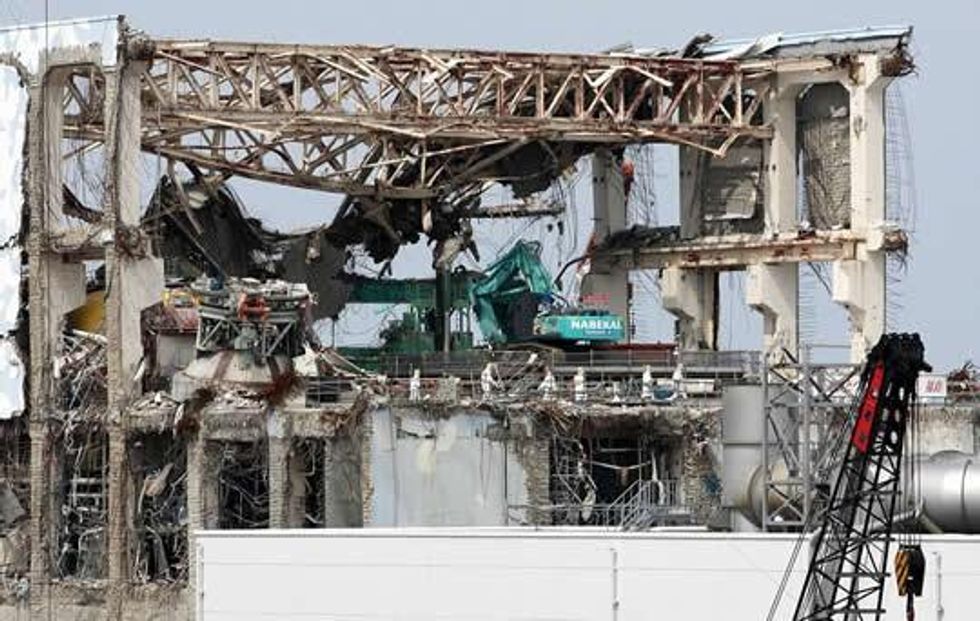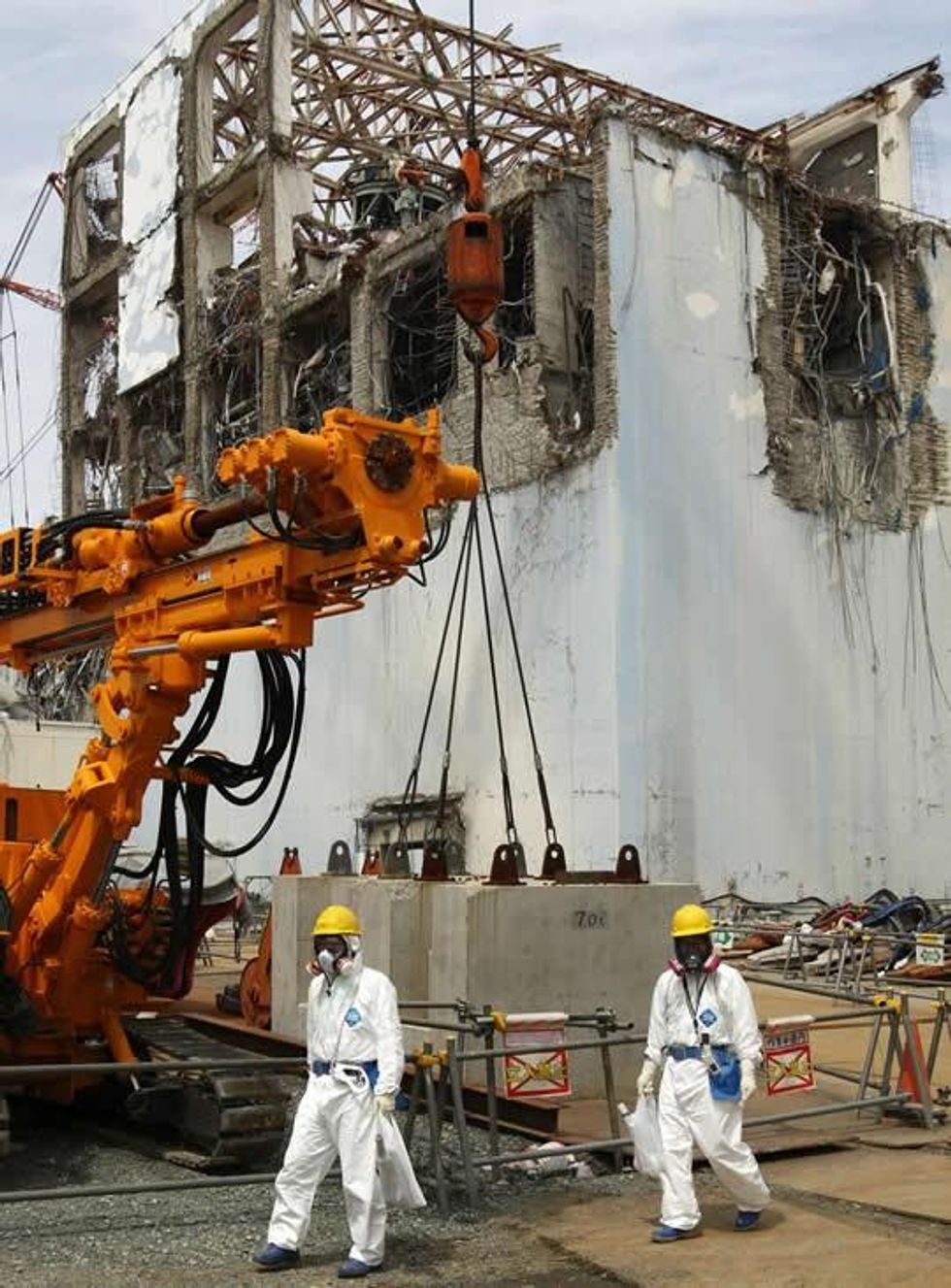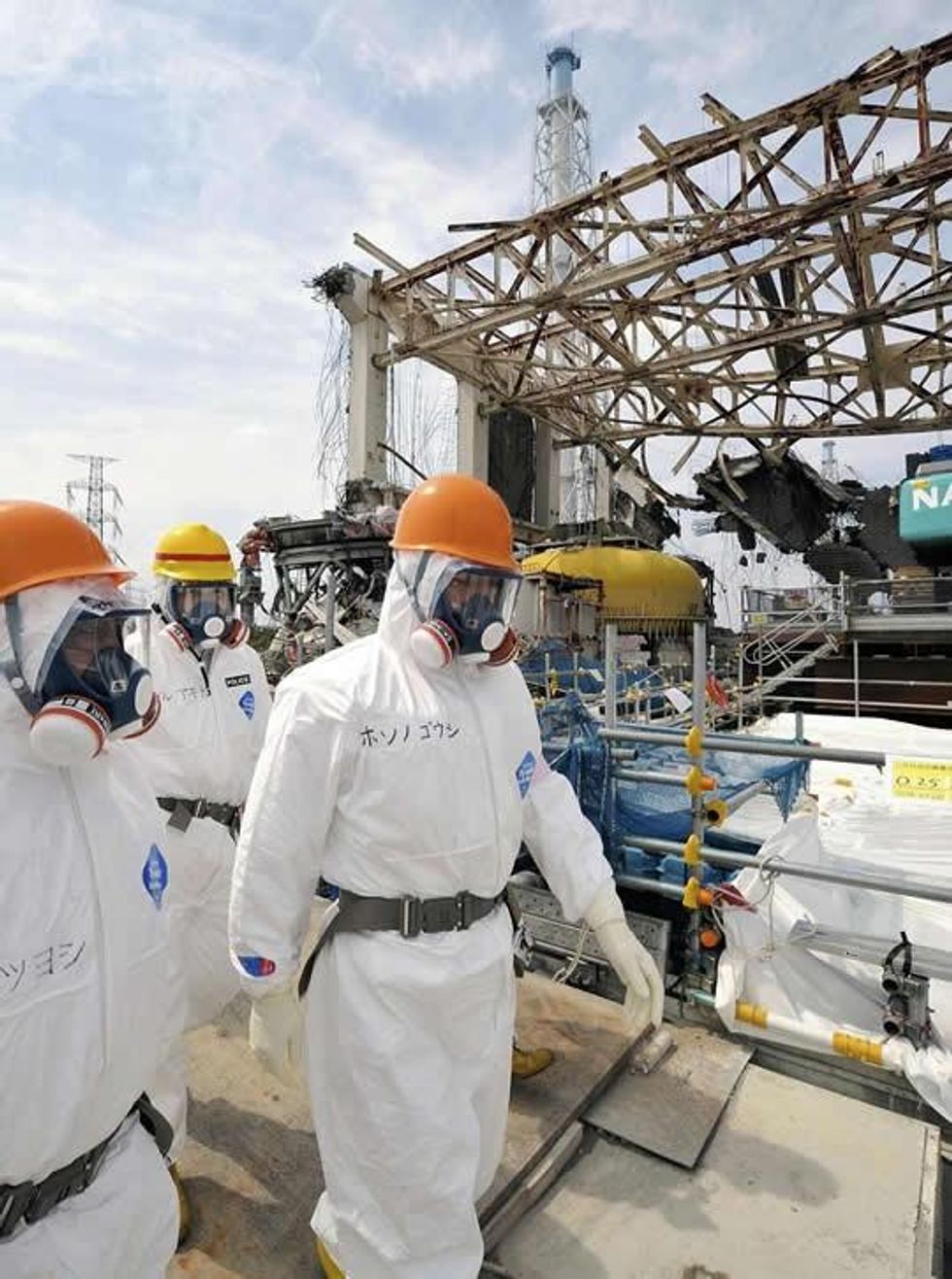

SUBSCRIBE TO OUR FREE NEWSLETTER
Daily news & progressive opinion—funded by the people, not the corporations—delivered straight to your inbox.
5
#000000
#FFFFFF
To donate by check, phone, or other method, see our More Ways to Give page.


Daily news & progressive opinion—funded by the people, not the corporations—delivered straight to your inbox.
A new bulge in the walls of the Fukushima Unit 4 nuclear plant has driven growing new fears over in Japan.
Attention has focused on Unit 4's spent fuel pool because of the large number of assemblies filled with rods that are stored high above the ground at that severly damaged reactor building. Three other reactor buildings at the site are also badly damaged, but their pools hold fewer used assemblies.
On Saturday Japan's government sent Environment and Nuclear Minister Goshi Hosonoto to inspect Unit 4.
Mr Hosono said the government accepted the Tokyo Electric Power Company's assurances that reinforcement work had shored up the building.
But many Japanese have scoffed at such assurances and point out that the pool's cooling system has malfunctioned several times.
''The No. 4 reactor is visibly damaged and in a fragile state, down to the floor that holds the spent fuel pool,'' said Hiroaki Koide, an assistant professor at Kyoto University's Research Reactor Institute. ''Any radioactive release could be huge and go directly into the environment.''
* * *
The New York Times reports:
What passes for normal at the Fukushima Daiichi plant today would have caused shudders among even the most sanguine of experts before an earthquake and tsunami set off the world's second most serious nuclear crisis after Chernobyl.
Fourteen months after the accident, a pool brimming with used fuel rods and filled with vast quantities of radioactive cesium still sits on the top floor of a heavily damaged reactor building, covered only with plastic.
The public's fears about the pool have grown in recent months as some scientists have warned that it has the most potential for setting off a new catastrophe, now that the three nuclear reactors that suffered meltdowns are in a more stable state, and as frequent quakes continue to rattle the region.
Senator Wyden, whose state could lie in the path of any new radioactive plumes, is among those pushing for faster action. After his recent visit to the ravaged plant, he said the pool at No. 4 poses "an extraordinary and continuing risk" and the retrieval of spent fuel "should be a priority, given the possibility of further earthquakes."The worries picked up new traction in recent days after the operator of the plant, Tokyo Electric Power Company, or Tepco, said it had found a slight bulge in one of the walls of the reactor building, stoking fears over the building's safety.
To try to quell such worries, the government sent the environment and nuclear minister to the plant on Saturday, where he climbed a makeshift staircase in protective garb to look at the structure supporting the pool, which he said appeared sound. The minister, Goshi Hosono, added that although the government accepted Tepco's assurances that reinforcement work had shored up the building, it ordered the company to conduct further studies because of the bulge. [...]
"The No. 4 reactor is visibly damaged and in a fragile state, down to the floor that holds the spent fuel pool," said Hiroaki Koide, an assistant professor at Kyoto University's Research Reactor Institute and one of the experts raising concerns. "Any radioactive release could be huge and go directly into the environment."
Senator Ron Wyden, Democrat of Oregon, expressed similar concerns during a trip to Japan last month.
The fears over the pool at Reactor No. 4 are helping to undermine assurances by Tepco and the Japanese government that the Fukushima plant has been stabilized, and are highlighting how complicated the cleanup of the site, expected to take decades, will be. The concerns are also raising questions about whether Japan's all-out effort to convince its citizens that nuclear power is safe kept the authorities from exploring other -- and some say safer -- options for storing used fuel rods.
"It was taboo to raise questions about the spent fuel that was piling up," said Hideo Kimura, who worked as a nuclear fuel engineer at the Fukushima Daiichi plant in the 1990s. "But it was clear that there was nowhere for the spent fuel to go."
The worst-case situations for Reactor No. 4 would be for the pool to run dry if there is another problem with the cooling system and the rods catch fire, releasing enormous amounts of radioactive material, or for fission to restart if the metal panels that separate the rods are knocked over in a quake. That would be especially bad because the pool, unlike reactors, lacks containment vessels to hold in radioactive materials. (Even the roof that used to exist would be no match if the rods caught fire, for instance.)
Senator Wyden, whose state could lie in the path of any new radioactive plumes and who has studied nuclear waste issues, is among those pushing for faster action. After his recent visit to the ravaged plant, he said the pool at No. 4 poses "an extraordinary and continuing risk" and the retrieval of spent fuel "should be a priority, given the possibility of further earthquakes."
Attention has focused on No. 4's spent fuel pool because of the large number of assemblies filled with rods that are stored at that reactor building. Three other reactor buildings at the site are also badly damaged, but their pools hold fewer used assemblies.
According to Tepco, the pool at the No. 4 reactor, which was not operating at the time of the accident, holds 1,331 spent fuel assemblies, which each contain dozens of rods. Several thousand rods were removed from the core just three months before so the vessel could be inspected. Those rods, which were not fully used up, could more easily support chain reactions than the fully spent fuel.
* * *






* * *
# # #
Dear Common Dreams reader, The U.S. is on a fast track to authoritarianism like nothing I've ever seen. Meanwhile, corporate news outlets are utterly capitulating to Trump, twisting their coverage to avoid drawing his ire while lining up to stuff cash in his pockets. That's why I believe that Common Dreams is doing the best and most consequential reporting that we've ever done. Our small but mighty team is a progressive reporting powerhouse, covering the news every day that the corporate media never will. Our mission has always been simple: To inform. To inspire. And to ignite change for the common good. Now here's the key piece that I want all our readers to understand: None of this would be possible without your financial support. That's not just some fundraising cliche. It's the absolute and literal truth. We don't accept corporate advertising and never will. We don't have a paywall because we don't think people should be blocked from critical news based on their ability to pay. Everything we do is funded by the donations of readers like you. Will you donate now to help power the nonprofit, independent reporting of Common Dreams? Thank you for being a vital member of our community. Together, we can keep independent journalism alive when it’s needed most. - Craig Brown, Co-founder |
A new bulge in the walls of the Fukushima Unit 4 nuclear plant has driven growing new fears over in Japan.
Attention has focused on Unit 4's spent fuel pool because of the large number of assemblies filled with rods that are stored high above the ground at that severly damaged reactor building. Three other reactor buildings at the site are also badly damaged, but their pools hold fewer used assemblies.
On Saturday Japan's government sent Environment and Nuclear Minister Goshi Hosonoto to inspect Unit 4.
Mr Hosono said the government accepted the Tokyo Electric Power Company's assurances that reinforcement work had shored up the building.
But many Japanese have scoffed at such assurances and point out that the pool's cooling system has malfunctioned several times.
''The No. 4 reactor is visibly damaged and in a fragile state, down to the floor that holds the spent fuel pool,'' said Hiroaki Koide, an assistant professor at Kyoto University's Research Reactor Institute. ''Any radioactive release could be huge and go directly into the environment.''
* * *
The New York Times reports:
What passes for normal at the Fukushima Daiichi plant today would have caused shudders among even the most sanguine of experts before an earthquake and tsunami set off the world's second most serious nuclear crisis after Chernobyl.
Fourteen months after the accident, a pool brimming with used fuel rods and filled with vast quantities of radioactive cesium still sits on the top floor of a heavily damaged reactor building, covered only with plastic.
The public's fears about the pool have grown in recent months as some scientists have warned that it has the most potential for setting off a new catastrophe, now that the three nuclear reactors that suffered meltdowns are in a more stable state, and as frequent quakes continue to rattle the region.
Senator Wyden, whose state could lie in the path of any new radioactive plumes, is among those pushing for faster action. After his recent visit to the ravaged plant, he said the pool at No. 4 poses "an extraordinary and continuing risk" and the retrieval of spent fuel "should be a priority, given the possibility of further earthquakes."The worries picked up new traction in recent days after the operator of the plant, Tokyo Electric Power Company, or Tepco, said it had found a slight bulge in one of the walls of the reactor building, stoking fears over the building's safety.
To try to quell such worries, the government sent the environment and nuclear minister to the plant on Saturday, where he climbed a makeshift staircase in protective garb to look at the structure supporting the pool, which he said appeared sound. The minister, Goshi Hosono, added that although the government accepted Tepco's assurances that reinforcement work had shored up the building, it ordered the company to conduct further studies because of the bulge. [...]
"The No. 4 reactor is visibly damaged and in a fragile state, down to the floor that holds the spent fuel pool," said Hiroaki Koide, an assistant professor at Kyoto University's Research Reactor Institute and one of the experts raising concerns. "Any radioactive release could be huge and go directly into the environment."
Senator Ron Wyden, Democrat of Oregon, expressed similar concerns during a trip to Japan last month.
The fears over the pool at Reactor No. 4 are helping to undermine assurances by Tepco and the Japanese government that the Fukushima plant has been stabilized, and are highlighting how complicated the cleanup of the site, expected to take decades, will be. The concerns are also raising questions about whether Japan's all-out effort to convince its citizens that nuclear power is safe kept the authorities from exploring other -- and some say safer -- options for storing used fuel rods.
"It was taboo to raise questions about the spent fuel that was piling up," said Hideo Kimura, who worked as a nuclear fuel engineer at the Fukushima Daiichi plant in the 1990s. "But it was clear that there was nowhere for the spent fuel to go."
The worst-case situations for Reactor No. 4 would be for the pool to run dry if there is another problem with the cooling system and the rods catch fire, releasing enormous amounts of radioactive material, or for fission to restart if the metal panels that separate the rods are knocked over in a quake. That would be especially bad because the pool, unlike reactors, lacks containment vessels to hold in radioactive materials. (Even the roof that used to exist would be no match if the rods caught fire, for instance.)
Senator Wyden, whose state could lie in the path of any new radioactive plumes and who has studied nuclear waste issues, is among those pushing for faster action. After his recent visit to the ravaged plant, he said the pool at No. 4 poses "an extraordinary and continuing risk" and the retrieval of spent fuel "should be a priority, given the possibility of further earthquakes."
Attention has focused on No. 4's spent fuel pool because of the large number of assemblies filled with rods that are stored at that reactor building. Three other reactor buildings at the site are also badly damaged, but their pools hold fewer used assemblies.
According to Tepco, the pool at the No. 4 reactor, which was not operating at the time of the accident, holds 1,331 spent fuel assemblies, which each contain dozens of rods. Several thousand rods were removed from the core just three months before so the vessel could be inspected. Those rods, which were not fully used up, could more easily support chain reactions than the fully spent fuel.
* * *






* * *
# # #
A new bulge in the walls of the Fukushima Unit 4 nuclear plant has driven growing new fears over in Japan.
Attention has focused on Unit 4's spent fuel pool because of the large number of assemblies filled with rods that are stored high above the ground at that severly damaged reactor building. Three other reactor buildings at the site are also badly damaged, but their pools hold fewer used assemblies.
On Saturday Japan's government sent Environment and Nuclear Minister Goshi Hosonoto to inspect Unit 4.
Mr Hosono said the government accepted the Tokyo Electric Power Company's assurances that reinforcement work had shored up the building.
But many Japanese have scoffed at such assurances and point out that the pool's cooling system has malfunctioned several times.
''The No. 4 reactor is visibly damaged and in a fragile state, down to the floor that holds the spent fuel pool,'' said Hiroaki Koide, an assistant professor at Kyoto University's Research Reactor Institute. ''Any radioactive release could be huge and go directly into the environment.''
* * *
The New York Times reports:
What passes for normal at the Fukushima Daiichi plant today would have caused shudders among even the most sanguine of experts before an earthquake and tsunami set off the world's second most serious nuclear crisis after Chernobyl.
Fourteen months after the accident, a pool brimming with used fuel rods and filled with vast quantities of radioactive cesium still sits on the top floor of a heavily damaged reactor building, covered only with plastic.
The public's fears about the pool have grown in recent months as some scientists have warned that it has the most potential for setting off a new catastrophe, now that the three nuclear reactors that suffered meltdowns are in a more stable state, and as frequent quakes continue to rattle the region.
Senator Wyden, whose state could lie in the path of any new radioactive plumes, is among those pushing for faster action. After his recent visit to the ravaged plant, he said the pool at No. 4 poses "an extraordinary and continuing risk" and the retrieval of spent fuel "should be a priority, given the possibility of further earthquakes."The worries picked up new traction in recent days after the operator of the plant, Tokyo Electric Power Company, or Tepco, said it had found a slight bulge in one of the walls of the reactor building, stoking fears over the building's safety.
To try to quell such worries, the government sent the environment and nuclear minister to the plant on Saturday, where he climbed a makeshift staircase in protective garb to look at the structure supporting the pool, which he said appeared sound. The minister, Goshi Hosono, added that although the government accepted Tepco's assurances that reinforcement work had shored up the building, it ordered the company to conduct further studies because of the bulge. [...]
"The No. 4 reactor is visibly damaged and in a fragile state, down to the floor that holds the spent fuel pool," said Hiroaki Koide, an assistant professor at Kyoto University's Research Reactor Institute and one of the experts raising concerns. "Any radioactive release could be huge and go directly into the environment."
Senator Ron Wyden, Democrat of Oregon, expressed similar concerns during a trip to Japan last month.
The fears over the pool at Reactor No. 4 are helping to undermine assurances by Tepco and the Japanese government that the Fukushima plant has been stabilized, and are highlighting how complicated the cleanup of the site, expected to take decades, will be. The concerns are also raising questions about whether Japan's all-out effort to convince its citizens that nuclear power is safe kept the authorities from exploring other -- and some say safer -- options for storing used fuel rods.
"It was taboo to raise questions about the spent fuel that was piling up," said Hideo Kimura, who worked as a nuclear fuel engineer at the Fukushima Daiichi plant in the 1990s. "But it was clear that there was nowhere for the spent fuel to go."
The worst-case situations for Reactor No. 4 would be for the pool to run dry if there is another problem with the cooling system and the rods catch fire, releasing enormous amounts of radioactive material, or for fission to restart if the metal panels that separate the rods are knocked over in a quake. That would be especially bad because the pool, unlike reactors, lacks containment vessels to hold in radioactive materials. (Even the roof that used to exist would be no match if the rods caught fire, for instance.)
Senator Wyden, whose state could lie in the path of any new radioactive plumes and who has studied nuclear waste issues, is among those pushing for faster action. After his recent visit to the ravaged plant, he said the pool at No. 4 poses "an extraordinary and continuing risk" and the retrieval of spent fuel "should be a priority, given the possibility of further earthquakes."
Attention has focused on No. 4's spent fuel pool because of the large number of assemblies filled with rods that are stored at that reactor building. Three other reactor buildings at the site are also badly damaged, but their pools hold fewer used assemblies.
According to Tepco, the pool at the No. 4 reactor, which was not operating at the time of the accident, holds 1,331 spent fuel assemblies, which each contain dozens of rods. Several thousand rods were removed from the core just three months before so the vessel could be inspected. Those rods, which were not fully used up, could more easily support chain reactions than the fully spent fuel.
* * *






* * *
# # #